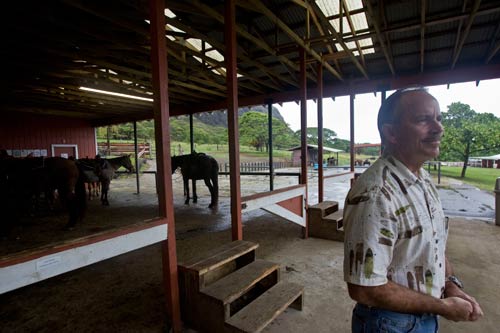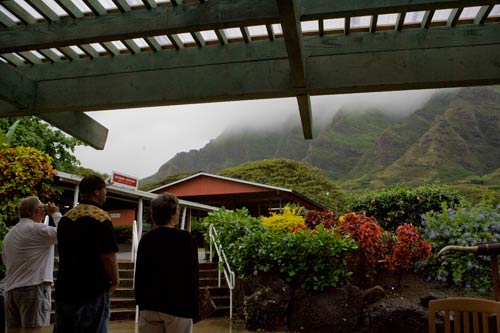Kualoa Ranch to market beef

While agriculture and land stewardship remain a focus at Kualoa Ranch, tourism has provided needed economic diversification. Here, Kualoa Ranch President John Morgan walks through one of the ranch’s horse stables.

Kualoa Ranch plans to market its grass-fed beef online and at its visitor center.


Despite Oahu’s down economy and challenging visitor market, Kualoa Ranch is beefing up their operations — literally.
Kualoa, which occupies 4,000 acres along Oahu’s northeastern coast and just celebrated its 160th year, has been involved in cattle ranching since the 1870s. The ranch, which is often used as a movie backdrop, also provides recreational activities including ATV tours, horseback rides, ocean voyaging and hula lessons as well as tours of its 800-year-old Molii Fishpond, gardens, movie sites and remote valley.
Kualoa already serves cafe patrons its own ranch-grown, grass-fed beef. But, starting in mid-2011, it will begin retailing the raw product as Kualoa Beef online and at its visitor center, said John Morgan, Kualoa Ranch’s president. Morgan is a descendant of Dr. Gerrit Judd, who bought the first 622 acres of the ranch from King Kamehameha III in 1850.
"Business expansion is always something that we are looking at," Morgan said. "We are trying to make everybody aware of the history and the importance of the ranch’s mission while at the same time trying to be as profitable as possible. We want to run this like a regular corporation that gets returns on equity."
Business growth is vital to stewardship of the ranch lands as well as keeping them in the family, he said.
In 1971 the City and County of Honolulu condemned 155 acres of Kualoa Ranch and turned it into Kualoa Regional Park, Morgan said.
Don't miss out on what's happening!
Stay in touch with breaking news, as it happens, conveniently in your email inbox. It's FREE!
"I grew up in a home on those lands," he said.
Since then two other attempts have been made to condemn other portions of the ranch, he said. The family has fought additional condemnation by turning the ranch into a destination attraction and an economic engine, Morgan said.
"We’ve learned that it’s very important to share this land," he said. "When I was growing up, the attitude of my grandmother and great-aunt was that this is our property and everyone stay out. They were gracious people, with a very different approach."
While agriculture and stewardship of the land remain the key focus for the Morgan family, tourism and retail have provided needed economic diversification, he said. Last year, profitability enabled the ranch to offer community programs for about 14,000 people.
"We knew that an agricultural operation with under 4,000 acres with hardly any income and profits was not sustainable," Morgan said. "We needed to develop business with the prospect of growing."
A decade after the Judd family purchased Kualoa, it became home to Oahu’s first sugar mill, which operated there from 1863 until it went bankrupt and closed in 1871. Soon after, the family began its cattle ranching operations. Over time they added acreage in Hakipuu and Kaaawa. Today about 500 head of cattle graze on roughly 1,500 acres of pasture. The herd is mostly made up of Angus, Brangus and Hereford stock.
"Going back to the beginning, every person in every generation who had the influence had this real devotion to the property and preserving the property," Morgan said. "Maximum financial return was not as important as preservation of the land. We are very fortunate that even the next generation feels that way."
But while it is an "honor to be part of such an illustrious legacy," Morgan said past successes and failures "show how far the most recent generation needs to plan ahead."
The ranch’s entry into tourism in 1985 provided a good start, he said. But business struggled after the Asian financial crisis and after Sept. 11, 2001, Morgan said.
"We lost a lot of money," he said.
With the opening of a visitor center in 2004 and a shift back to tours that focused on nature and culture, the ranch gained market share, Morgan said.
The ranch was appealing enough to get honeymooners Maxine and Daniel Viola out of their room and into two tours. The Perth, Australia, couple recently took the ranch’s movie tour and then decided to book an ATV tour to explore it more.
"We recognized most of the sites from the movies. It was really quite lovely," said Maxine Viola.
The couple said attractions like Kualoa enhanced their trip.
"It had a real island feel," Daniel Viola said.
Newer tours showcase Kualoa’s importance to native Hawaiians and its spectacular natural beauty, Morgan said. Formerly the residence of a ruling chief, Kualoa was once a training ground where royalty were instructed in war, history and social traditions, he said. The early Hawaiians cultivated taro on the ranch’s Hakipuu Valley lands, he said. They also harvested food from Molii Fishpond, considered one of the state’s largest and most preserved fishponds.
By focusing on the ranch’s strongest aspects, "we never saw the most recent downturn," he said.
The move into beef retailing will be the most significant business change since the Morgan family opened up their private ranch to visitors some 25 years ago, he said.
"We think we can make money at it. It’s a great brand builder," Morgan said. "The local market is very important to us, and the more ways that we can reach them, the better it is for us."
The ranch also expects to tap into the growing "locavore" movement, which encourages consumption of nearby food sources, said Valerie King, the ranch’s marketing director.
"Sustainability has become a very popular concept," she said.
Prices will retail for a slight premium over beef that is imported to the isles, Morgan said.
In addition, Kualoa will expand its other agricultural enterprises: its film presence and its tourist offerings, he said.
"We are hoping to make progress in 2011 rehabilitating some of our diversified (agricultural) lands that have gone fallow," Morgan said. "We will resurrect 100 acres over the next 10 years and are looking at selling tropical fruit in the future. Only about 2,000 of the ranch’s acres currently are used for agriculture."
Kualoa also will introduce two new higher-end tourism products next year. The Royal Experience, an intimate, private half-day tour for guests who want to see otherwise off-limit parts of the ranch, will retail for $169. Another tour, the Kualoa Sunset Experience, will open the ranch for the first time to evening visitors. Tours, which will retail for $99, will include dinner and open-air entertainment.
The ranch, which has been featured in films from the 1961 Elvis Presley hit "Blue Hawaii" to the more recent "Jurassic Park," "Pearl Harbor" and "50 First Dates," will continue to consider opportunities that allow it to share its beauty with a broader audience. It was also a setting for television’s "Lost" and continues to welcome "Hawaii Five-0" TV crews, Morgan said.
"There is mana (power) in the lands of Kualoa, and it is felt by those who come here," he said. "My family and everyone who has had a hand in maintaining Kualoa and sharing its mana are honored to be a part of such an extraordinary place."
A historic time line of Kualoa Ranch
1828: Dr. Gerrit Judd leaves New England to become a medical missionary in Hawaii.
1842: Dr. Gerrit Judd renounces his U.S. citizenship and becomes a full-time adviser to King Kamehameha III.
1850: King Kamehameha III sells Kualoa, 622 acres of land including Mokolii island (Chinaman’s Hat), to Judd for $1,300.
1860: Judd’s son, Charles H. Judd, purchases an additional 2,000 acres in Kaaawa.
1863: Charles Judd and his brother-in-law Samuel Wilder buy Kualoa and start a sugar plantation.
1871: Insufficient rainfall contributes to poor sugar plantation yields, and Oahu’s first sugar plantation closes.
1880: Charles Judd purchases most of the lands of Hakipuu from Queen Kalama’s land holdings.
1927: Julie Judd Swanzy, Charles Judd’s daughter, buys out her siblings and becomes sole owner of Kualoa.
1941: The U.S. military takes over most of Kualoa, building a coastal artillery defense battery and an airstrip.
1946: The town of Kaaawa is created out of old pastures and farm lots. About 200 residential lots are leased.
1961: Kualoa makes its Hollywood debut in "Blue Hawaii."
1971: The City and County of Honolulu, under Mayor Frank Fasi, condemns 155 acres of Kualoa, including Mokolii island, to create Kualoa Regional Park.
1976: Kualoa starts offering horseback rides to the public and leases out land for the development of an aquaculture facility in Hakipuu.
1985: Kualoa expands its outdoor recreational activity business beyond horseback rides. Other visitor activities include ATV rides, property tours, scuba diving, windsurfing, personal-watercraft and catamaran rides, shooting and helicopter rides.
1986: Kualoa offers educational programs to the public. As many as 14,000 kids a year benefit.
1989: Israel Kamakawiwo’ole and Steel Pulse give the ranch’s first outdoor concert.
1995: A professional mountain bike race is held in Kaaawa Valley.
2004: Kualoa builds its first visitor center and narrows its visitor offerings to five narrated tours, horseback rides and ATV rides.
2010: Kualoa Ranch begins serving Kualoa beef to visitor center cafe patrons.
2011: Kualoa Beef will be sold online. The first evening tours will start, and a more expensive behind-the-scenes tour will begin. The ranch will begin rehabilitating fallow lands and intends to eventually sell tropical fruit.
Source: Kualoa Ranch





